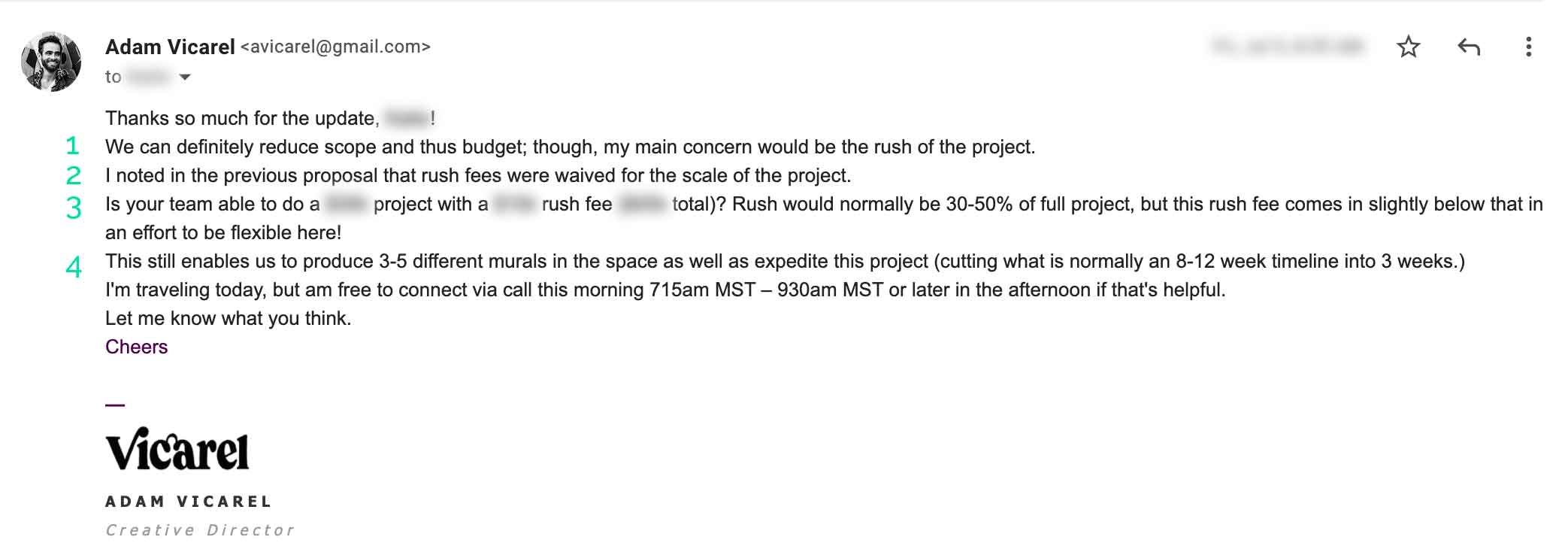How to use a rush fee and adjust a design scope of work for graphic design and mural projects.
Vol. 050
How to use a rush fee and adjust a design scope of work for graphic design and mural projects.
Mitigate stress, control the projects and manage expectations better through being more transparent, honest and standing your ground early on.
A quick bite:
Do you find yourself with clients whose timelines or budgets don’t align with your rates or your process? You’re not alone! However; these opportunities don’t need to be discarded. Simply having a conversation, adjusting your scope of work or adding rush fees might be the step you you need to take to land the work that pays you right!
Continue reading below…
Have you ever experienced this:
You exchange an email or two talking with a prospect about a project opportunity. Even after minimal correspondence you start to get excited about the opportunity: it sounds like a fun project, is a cool client, and/or is a potentially amazing portfolio piece.
But, then the topic of budget and timeline come up...
The next thing you know, the prospect needs this project completed 3x faster than your normal pace of work, or, they want this huge project for half the cost that you quoted. At this point, you’ve invested a good amount with calls, emails and brain power.
Your only option is to say yes and do double the work for half the price in a third of the time — or, you have to back out, right?!
WRONG!
After years of navigating these types of conversations, and through thoughtful and intentional push back, I’ve landed countless fun, high paying projects with amazing clients through understanding where to push back on their requests, specifically with adjustments to their scope of work or the application of rush fees.
Here’s a few tips on how to manage these types of conversations in a professional and productive way.
**Before you get started, remember: you have negotiation power in your client relationships too. The client “needs” you as much as you “need” them. This is a reciprocal relationship. Additionally, I wanted to note that the more dialed in your own processes are (for example, your logo design and branding process: having your on boarding, briefing, designing, presentation, revision and handoff process perfected) the better off you’ll be.
Add a rush fee
When your clients need a graphic designer for a project or mural painting completed within a shorter timeline than usual, it’s totally reasonable to add on a rush fee: an additional fee added to the project for accommodating a timeline outside of your usual process. Almost every business does this in some way: expedited shipping costs, “fast-passes” at amusement parks, etc.
If a project will keep you working until 11pm on logo designs, painting murals on weekends, or under more stress than normal because of your client-imposed timelines, you should be compensated accordingly.
But how?
Rush fees can range from 25–300 percent of the original job cost: Full job cost (your rate) + 200% (rush fee) = rush fee total. For example: $1,000 project + $2,000 (200% rush fee) = $3,000 project total.
What’s the goal of a rush fee? For me, I hope to deter my client from rushing the project. My hope is that they see this and say “Oh wow, yeah, I don’t want to pay that. I can wait.” And, if they don’t say that, I not only make good money on the project and have the opportunity to outsource it with the extra profit, but I also might realize that I need to raise my graphic design or mural rates!
Changing a project scope of work
Its very common that your client may not full understand what they’re asking for, and they likely come by it honestly. Consider hopping on a call with your insurance agent — if you’re like me, you probably have no idea what the hell they’re saying. This is oftentimes a similar scenario with your prospects.
To paint an exaggerated example: if someone asks you for 3 logos, multiple patterns, textures, typography system, color palette, expansive marketing collateral, a website and digital assets for that website and social media, and says they need it next week for $1,000, this is clearly someone who doesn’t understand the graphic design industry.
When I receive requests that fall outta line (they’re oftentimes not that bad) I simply make scope of work adjustment suggestions.
Let’s say a client has a max $7,500 budget, but they want a full branding kit (something for which we charge a minimum rate of $10k). If it’s a project or client with whom I’m interested in working, I’ll be flexible. I won’t say “nope, sorry, you need $2.5k more.” I’ll suggest that “Because your budget is below our minimum, we can reduce the amount of options presented and revisions done on the branding”. In these instances, i’ll present 2 directions with 2 rounds of feedback (instead of 3 and 3).
Moving forward, there will be a mutual respect for each other and the work created. Your client will likely be more trusting of the work created when you’re transparent up front and they’re treated professionally in a manner such as this.
Remember: its not your job to fulfill every random request that comes in. Your job is to vet clients and opportunities, and assess if you’re each a good fit for each other, and how to best solve their problems with the allotted resources at hand.
Actual application of adding a rush fee and scope of work adjustment:
Below is a real world example of pushing back and discussing what’s possible in a professional and positive way. You’ll notice (from their email and mine) that professionalism, transparency and availability to talk further are at the forefront of my communication.
The email below came in response to my sending over the initial design project proposal.
Some project/contact info blurred for confidentiality:
They note that my quote was high. Did I panic and fear I had out priced myself? Absolutely not. This email came in response to a well throughout, thorough proposal (see #3) for a large scope of work. I simply took this as “reduce the scope of work to match our budget” not “do this scope for less money”. Get used to these types of conversations and back and forth — the more often you have them, the better you’ll get negotiating your projects and rates.
This conversation was about painting a few murals in the same space, and I had previously mentioned that a reduction in complexity of the mural painting or the total number of murals could reduce cost if needed — they reiterates this. Here they also note what their budget is.
This is important: because I had previously noted the ability to be flexible in deliverables/pricing, they didn’t receive the proposal and think “this price is too high, find someone else.” They thought “let’s talk more.”
“Thank you for your super organized estimate.” Professionalism is key, y’all. Freelance graphic designers and mural artists aren’t necessarily known for being professional and organized. By being professional and organized you are carrying yourself in a manner that leadership or c-suite executives are accustomed to. You’re “talking their talk”. This builds trust, and helps you secure projects.
Here was my response:
I simply state that we can absolutely work within their budget, and we’ll simply adjust the amount of work created to accommodate that. Here, I also note that the timeline is what might be an issue because it’s far faster than normal.
In my previously sent design proposal and SOW, I estimated the project cost and I chose to waive the rush fees. This was a choice I had made because the project payout was large enough/high paying enough to justify doing so, and I wanted to show the client that I’m here as a partner, not just someone trying to get as much money as possible by tacking on additional fees. However; (this however is key!), I also noted in that previously sent over SOW that “if this project SOW changes [i.e., if we move forward with a smaller version of this project], the project rush fees may be reapplied.” With their request to reduce the scope I was able to reapply the rush fee without an awkward conversation.
Because I now know their max budget, I was able to suggest a new rate for the project + rush fee with a total that was equal to their budget for this project. Ultimately this means that the SOW was slightly less than what they had requested, but we had to reduce the scope in order to account for the premium paid for the rushed timeline.
Here I continued to reiterate that while yes the rush fee is applied, I was again working to be flexible and give a bit of grace to prove my partnership. I don’t need to do this; however, continuing to show flexibility and that you’re working WITH them to be a partner (investment) as opposed to simply being a vendor (expense) more likely opens the door to opportunities in the future.
Reiterate the value of your offering. Succinctly note what you’re doing to accommodate them, and that it’s outside of the norm.
The goal in an email correspondence like this is to show your client that:
You’re professional: you have set processes, timelines and ways of working. This makes them feel confident in your ability to deliver and your value.
You’re flexible: you’re willing to make adjustments to accommodate their needs (within reason). You are an investment not an expense.
You’re valuable: while yes, you are flexible, you also don’t “need them” (they need you!). Setting a price and setting a rush fee (based on a percentage of the final project fee) conveys that your work and process are valuable.
Standing your ground on timelines and/or rush fees like this benefits you in 3 ways:
Timeline: You often uncover that your client doesn’t actually NEED the work when they say they do. They will often push their timeline back to avoid rush fees, allowing you to work at your normal pace — stress free!
Payment: If your client does NEED the work when they say, then you’re able to make a bit of extra cash for accommodating their rushed needs. This is extra profit in your pocket or enough to justify hiring another graphic designer to support the work.
Relationship: If they’re not willing to do either of the above, sometimes this is a bullet dodged! In my early years I took on many projects where I didn’t charge a rush fee, or I simply lowered my price to accommodate their budget without adjusting the scope (don’t do this arbitrarily!!). Ultimately, these clients prove to be hard to work with, they nickel and dimed me, and they’re the ones who needed countless revisions.
When your prospects request doesn’t align with your normal flow, consider how changing your scope of work or adding rush fees could apply. If that doesn’t work, then maybe the work shouldn’t happen! Turning away a client is not a bad thing. In fact, it’s often beneficial. When you say no to an opportunity because it is not a good fit for you (or you for them) you’re making room for a better opportunity for yourself in the future!
I hope that breaking down that email helps explain how I am both rooted in my process and value but also offer flexibility to my clients.




